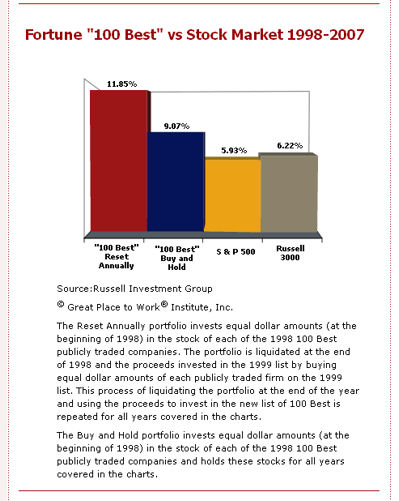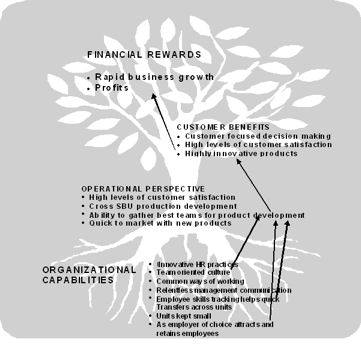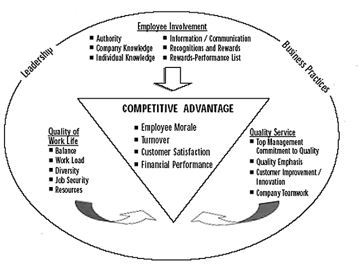What is the best way to get out in front of your competition?
- high tech development
- access to financial assets
- R & D
- industry boundaries
These approaches may have worked in the past – but they are becoming increasingly ineffective as technologies merge, regulations are relaxed and companies form powerful strategic alliances. Savvy, fast-growing companies understand this; that’s why they are developing new ways to achieve competitive advantage through their own people and organizational capabilities.
To win in the new business world a firm must create value in ways that:
- differ from competitors’ approaches
- cannot be easily copied
The reality is your competitors can obtain capital and technology — and they can match even your most creative pricing strategies. However, it’s more difficult to recreate your culture, value system, operating principles, leadership style and management philosophy — in sum, your people are the foundation of your organizational capability .
Simply put, organizational capability is a company’s ability to anticipate and adapt to changing customer needs and marketplace forces, made possible through its people, culture, internal structures, policies, and practices. Now for the analogy. If the flowers, leaves and fruit of a tree are the value it delivers, the roots represent organizational capability. Just as roots are usually hidden below the surface, so is organizational capability. That’s why once organizational capability is developed and contributes to a company’s success, it cannot be easily copied; it becomes a firm’s premier competitive advantage.
Take a look at the financial performance of companies who understand the importance of their people. This is from the Best Places To Work Institute, they measure Fortune magazines “Best Companies To work For” a proxy for people focused companies. These companies outperformed market indices.

When you think about it, this makes sense – it is the intellectual capital, what is in the minds and hearts of people – rather than the buildings, the tools, the financial capital — that has the power to truly differentiate and grow a business – and beat the competition.
Back to the tree analogy. A closer look at a computer hardware company shows: a team oriented culture, the ability to hire and keep skilled people and when these are combined with the ability to track skills the result is effective product development teams. These teams produce innovative products, which eventually yield financial success. Organizational capabilities flow up the “tree” and though difficult to observe, they produce very visible results.
Companies who don’t already know that their people are crucial to business success would do well to read an excellent short article “Corporate Culture Does Make a Difference For a Competitive Advantage” . The authors capture what these companies need to do.
Culture for Excellence
Employee Involvement … means that employees at all levels of the organization are involved in the running of the business. In an environment supportive of Employee Involvement,
- employees have the authority to make decisions and contribute to the business (Authority);
- employees have a good understanding of the business and how the organization operates (Company Knowledge);
- employees receive sufficient training and development opportunities (Individual Knowledge);
- there is open and ongoing communication between management and employees (Information & Communication);
- employees receive recognition and rewards for their contributions to thecompany (Recognition & Rewards); and,
- there is a link between organizational rewards and performance(Rewards-Performance Link).
Quality of Work Life means that employees receive both personal and work-related support from the company. In a company supportive of a positive Quality of Work Life, employees:
- are able to balance their work and personal demands effectively(Balance);
- have challenging but reasonable work loads (Work Load).
- are treated fairly regardless of demographic differences such as gender and race(Diversity).
- perceive a reasonable level of job security (Job Security); and
- have the tools, materials and equipment they need to perform their jobseffectively (Resources).
The concept of people as competitive has reached large companies such as US based Wells Fargo
Seems some ideas take time.
Ed Konczal has an MBA from New York University's Stern School of Business (with distinction). He has spent the last 10 years as an executive consultant focusing on human resources, leadership, market research, and business planning. Ed has over 10 years of top-level experience from AT&T in the areas of new ventures and business planning. He is co-author of the book "Simple Stories for Leadership Insight," published by University Press of America.



Brilliant! I could not agree more. I have worked for the past number of years with an organization that has lost sight of the value of its people. The focus has shifted dramatically away from the human to the financial. The culture has deteriorated in such a significant way that they are having a near impossible time keeping top quality contributors and they certainly are having a tough time attracting valuable replacements.
The one thing that really resonated with me in your article is “Authority”. If an organization does not trust and empower its employees to make decisions and contribute to the success of the vision and mission, the great ones will go somewhere else where their decision making is integral to an organization’s success.
Thanks for your research.
David,
Thanks for your insights. Perhaps if there were more people like you, corporations and employees would both prosper more.
Best wishes,
Ed